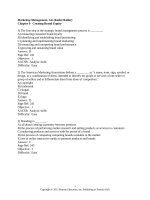Marketing quốc tế Slides BUSM2412 unit 9 s1 08 compatibility mode
Bạn đang xem bản rút gọn của tài liệu. Xem và tải ngay bản đầy đủ của tài liệu tại đây (1.71 MB, 24 trang )
Unit 9
Place: distribution strategies that
balance coverage and control
1
R d Map:
Road
M
Previewing
P i i the
th Concepts
C
t
Explain why companies use distribution channels
and discuss the functions these channels perform.
Discuss how channel members interact and how
they organize to perform the work of the channel.
Identify the major channel alternatives open to a
company.
Explain how companies select, motivate, and
evaluate channel members.
Discuss the nature and importance of marketing
logistics and supply chain management.
2
What is place?
Pl
Place or di
distribution
ib i strategy is
i about
b
making
ki
products available to customers when and
prefer to evaluate,, select,, buy,
y,
where theyy p
consumer and dispose of them.
Distribution channels are the means by which
products flow from producer/provider to
customer/consumer.
/
“Where” and “When” decisions are critical.
3
Wh t iis a Distribution
What
Di t ib ti Channel?
Ch
l?
Set of interdependent organisations
involved in the process of making a
product or service available for use or
consumption by the consumer or
business user.
user
4
Why are Marketing Intermediaries
Used?
The use of intermediaries results from their greater
efficiency in making goods available to target markets.
Offers the firm more than it can achieve on its own
through the intermediaries:
Contacts,
Experience,
Specialisation,
Scale of operation
operation.
Purpose: match supply from producers to demand from
consumers.
5
A Distributor Reduces the Number of
Channel Transactions (Fig. 11-1)
6
Key Channel Attrbutes
Economics
E
i
Recognises exactly where the costs and profits of each
distribution alternative are, or should be, made in any
channel.
Coverage
Optimises the availability of the product to the
targeted segments.
Control
O
Optimum
i
distribution
di ib i to customers whilst
hil not
surrendering too much decision-making authority over
the value proposition to other members of the
channel
channel.
7
Distribution Channel Functions
These Functions Should be Assigned to the Channel
Member Who Can Perform Them Most Efficiently and
Effectively.
Risk Taking
Information
Financing
Promotion
Physical
Distribution
Contact
Negotiation
Matching
8
List and briefly discuss the marketing channel
functions that are involved in completing and
fulfilling transactions.
c functions
u ct o s app
applyy most
ost in eac
each o
of tthe
e
Which
following situations?
A retailer puts in a rush re-order for a needed Tết
item that is in short supply.
An Internet marketer seeks ways to identify and
contact its market.
market
9
Number of Channel Levels
10
Channel Behaviour &
Organization
The channel will be most effective when:
each member is assigned tasks it can do best.
all members cooperate to attain overall channel goals and satisfy
the target market.
When
e tthiss does
doesn’tt happen,
appe , conflict
co ct occu
occurs:
s
Horizontal Conflict occurs among firms at the same level of the
channel, i.e retailer to retailer.
Vertical Conflict occurs between different levels of the same
channel, i.e. wholesaler to retailer.
Each channel member’s role must be specified and conflict
mustt b
be managed.
d
11
Conventional Distribution Channel
Vs. a Vertical Marketing System
12
Innovations in Marketing Systems
Horizontal Marketing
System
T
Two
or More
M
Companies
C
i
at One Channel Level
Join Together to
Follow a New
Marketing Opportunity.
Example:
Ni
Ninomaxx
in
i Diamond
Di
d
Plaza, Highlands
Coffee inside
Bookstore
Hybrid Marketing
System
A Single Firm Sets Up
Two or More Marketing
Channels to Reach One
or More Customer
Segments.
Example:
Retailers, Catalogs,
and Sales Force
13
Hybrid Marketing Channel
14
Changing
g g Channel Organisation
g
A Major
j Trend is Toward Disintermediation
Which Means that Product and Service
Producers are Bypassing Intermediaries
and Going Directly to Final Buyers or That
New Types of Channel Intermediaries are
Emerging to Displace Traditional Ones.
Ones
15
Channel Design Decisions
Analysing Consumer Service Needs
Setting Channel Objectives & Constraints
Identifying Major Alternatives
Types of
Intermediaries
Number of
Intermediaries
Responsibilities of
Intermediaries
Evaluating
l
the
h Major Alternatives
l
Designing
g g International Distribution Channels
16
Number of Marketing
Intermediaries
Intensive
Di t ib ti
Distribution
Selective
Distribution
Exclusive
Distribution
17
Decide which distribution strategy-gy
intensive, selective, or exclusive--is used
for the following products, and why:
KFC Chicken Burger
B ge
Aquafina Bottles (Small)
g Shoes
Nike Running
Bottled Cooking Gas
Honda Dream
18
Channel Management Decisions
Moti ating Channel Members
Motivating
Membe s
FEEDBACK
Selecting Channel Members
Evaluating Channel Members
19
Supply Chain Management
20
Goals of the Logistics
System
g
y
Higher Distribution Costs;
Hi h Customer
Higher
C t
Service
S i
Levels
Goal:
To Provide a Targeted Level of Customer Service
L tC
t
att th
the Least
Cost.
Lower Distribution Costs;
Lower Customer Service
Levels
21
Major
j Logistics
g
Functions
Order Processing
Received
Processed
Shipped
Costs
Minimize Costs of
Attaining Logistics
Objectives
Logistics
Transportation
T
t ti
Rail, Truck,
Water, Pipeline,
Ai Intermodal
Air,
I
d l
Functions
Inventory
When to order
How much to order
Just-in-time
Warehousing
Storage
Distribution
Automated
22
Integrated Logistics Management
C
Concept Recognises
i
that
h Providing
idi Better
Customer Service and Trimming
Distribution Costs Requires Teamwork,
Both Inside the Company and Among All
the Marketing Channel Organizations.
Involves:
Cross-functional teamwork inside the
company
Building channel partnerships
Third-party logistics
23
Rest Stop: Reviewing the Concept
Explain
l
why
h companies use distribution
d
b
channels
h
l
and discuss the functions these channels perform.
Discuss
Di
how
h
channel
h
l members
b
interact
i t
t and
d how
h
they organise to perform the work of the channel.
Identify the major channel alternatives open to a
company.
Explain how companies select,
select motivate,
motivate and
evaluate channel members.
Discuss the nature and importance of marketing
logistics and supply chain management.
24









